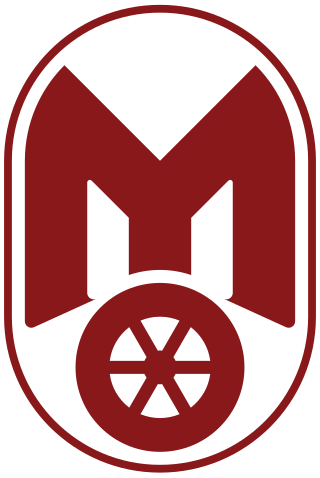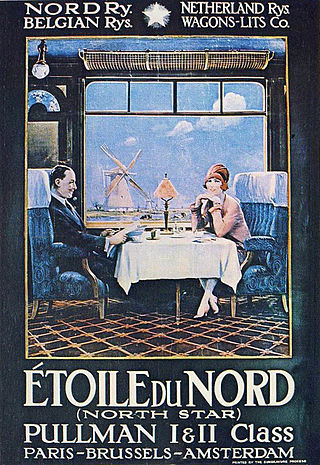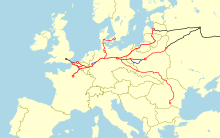
The Orient Express was a long-distance passenger train service created in 1883 by the Belgian company Compagnie Internationale des Wagons-Lits (CIWL) that operated until 2009. The train traveled the length of continental Europe, with main terminal stations in Paris in the northwest and Istanbul in the southeast, and branches extending service to Athens, Brussels, and London.

Newrest Wagons-Lits, formerly Compagnie internationale des wagons-lits, also CIWL, Compagnie des Wagons-Lits, or just Wagons-Lits, is a division of Newrest particularly known for its on-train catering and sleeping car services, as well as being the historical operator of the Orient Express.
The Chemins de fer du Nord, often referred to simply as the Nord company, was a rail transport company founded in September 1845 in Paris. It was owned by, among others, de Rothschild Frères of France, N M Rothschild & Sons of London, Charles Laffitte and Edward Blount, and Baron Jean–Henri Hottinguer. Baron James de Rothschild served as the company's president from its inception until his death in 1868.

Georges Lambert Casimir Nagelmackers was a Belgian civil engineer and businessman, famous for founding the Compagnie Internationale des Wagons-Lits and creating the Orient Express.

Mitropa was a catering company best known for having managed sleeping and dining cars of different German railways for most of the 20th century. Founded in 1916, the name "Mitropa" is an abbreviation of Mitteleuropa. The railway carriages displayed a distinct burgundy-red livery with the Mitropa logo.

In the summer of 1939, weeks ahead of the Nazi German and Soviet invasion of Poland the map of both Europe and Poland looked very different from today. The railway network of interwar Poland had little in common with the postwar reality of dramatically changing borders and political domination of the Soviet-style communism, as well as the pre-independence German, Austrian and Russian networks which the Second Polish Republic had partially inherited in 1918 after the end of World War I. The most important junctions in the Polish territory in summer of 1939 were:
The Night Ferry was an international boat train from London Victoria to Paris Gare du Nord that crossed the English Channel on a train ferry. It ran from 1936 until 1939 when it ceased due to the onset of World War II. It resumed in 1947, ceasing in 1980. It was operated by Compagnie Internationale des Wagons-Lits until 1977 and then British Rail.

The Venice Simplon-Orient-Express (VSOE) is a private luxury train service from London to Venice and other European cities. It is currently owned by Belmond.

Diatto was an Italian manufacturing company founded in 1835 in Turin by Guglielmo Diatto (1804–1864) to make 'carriages for wealthy customers'. In 1874 Guglielmo’s sons, Giovanni and Battista Diatto, began building railway carriages for Compagnie Internationale des Wagons-Lits and the Orient Express. In 1905 Guglielmo's grandsons, Vittorio and Pietro Diatto, began Diatto-Clément, a cooperative venture making motor-vehicles under license from French manufacturer Clément-Bayard owned by industrialist Adolphe Clément-Bayard. By 1909 they had full ownership of 'Autocostruzioni Diatto' and began developing their own motor-vehicles and exporting them worldwide.
The Calais-Mediterranée Express was a French luxury night express train which operated from 1886 to 2003. It gained international fame as the preferred train of wealthy and famous passengers between Calais and the French Riviera during the interwar period. It was colloquially referred to as Le Train Bleu in French and the Blue Train in English because of its dark-blue sleeping cars.

The Londres-Vichy Pullman Express was a Pullman train that ran between London and Vichy in France primarily to serve passengers wishing to visit the thermal baths for which Vichy was famous. The Compagnie Internationale des Wagons-Lits established the service on 14 May 1927.

The Taurus Express is a passenger train operating daily between Konya and Adana. In the past it was a premier overnight passenger train operated by Compagnie Internationale des Wagons-Lits between Istanbul and Baghdad. After 1972, passengers could travel down to Basra via connection to the Express 2 made at Baghdad Central Station. However, service was suspended in 2003, due to the outbreak of war in Iraq. In 2012, the State Railways renewed service between Eskişehir and Adana and will once again service Istanbul when track work in the city is complete. There is a chance that the train may continue to its former terminus in Baghdad in the future, but the possibility remains low for the time being.
The Compagnie Internationale des Grands Hôtels (CIGH) was founded on 11 April 1894 as a subsidiary of the railway company Compagnie Internationale des Wagons-Lits (CIWL). This hotel chain was established to provide the customers of CIWL with high quality accommodation before or after their train journey.

The Edelweiss was an international express train. For most of its existence, it linked the Netherlands with Switzerland, via Belgium, Luxembourg and France. Introduced in 1928, it was named after a mountain flower, the Edelweiss, which is associated with alpinism and the Alps, and regarded as a symbol of Switzerland.

The Étoile du Nord was an international express train. It linked Paris Nord in Paris, France, with Brussels, Belgium, and, for most of its existence, also with Amsterdam CS in Amsterdam, the Netherlands. Its name meant literally "Star of the North", and alluded not only to its route heading north from Paris, but also to one of its original operators, the Chemin de Fer du Nord.

Le Lyonnais, or the Lyonnais, was an express train that linked Paris and Lyon in France. Introduced in 1968, it was operated by the Société Nationale des Chemins de fer français (SNCF). The train is named after the geographical area known as the Lyonnais, a historical (former) French province, whose name came from the city of Lyon.

L'Oiseau Bleu was an international express train linking Antwerp with Paris. The train was named after the play L'Oiseau Bleu as a tribute to its author, the Belgian Nobel prize laureate Maurice Maeterlinck.

The Jules Verne was an express train that linked Paris and Nantes in France. Operated by the Société Nationale des Chemins de fer français (SNCF), it was the last new Trans Europ Express (TEE) to be introduced, in 1980.

Le Rhodanien, or the Rhodanien, was an express train with its southern terminus in Marseilles, France. Operated by the Société Nationale des Chemins de fer français (SNCF), it was named using the French language adjective derived from the Rhone river; the name alludes, amongst other things, to the river, its valley, and the dialect of the Franco-Provençal language that is spoken there.
Pullman Hotels and Resorts is a French multinational upscale hotel brand owned by Accor. Pullman has 145 hotels and resorts in 42 countries spread across Africa, the Americas, Asia, Europe, the Middle-East and Oceania.



















